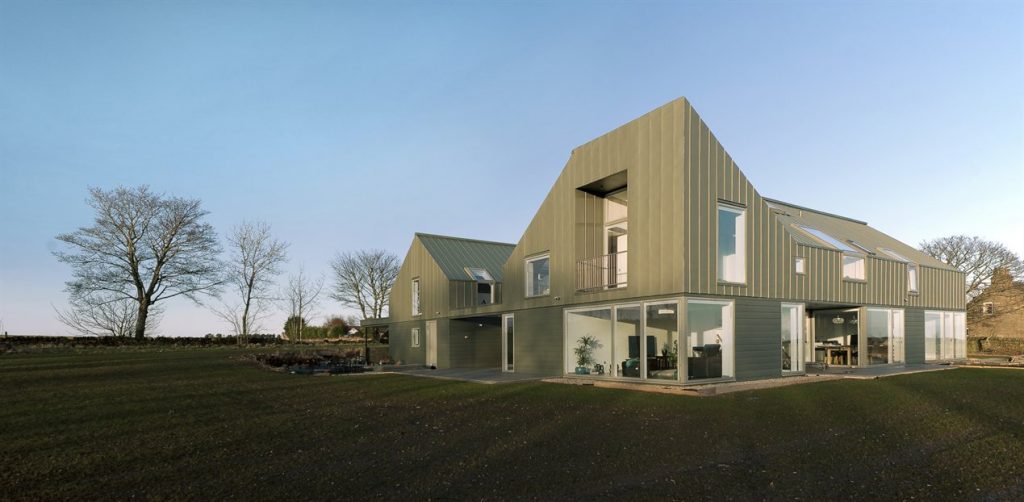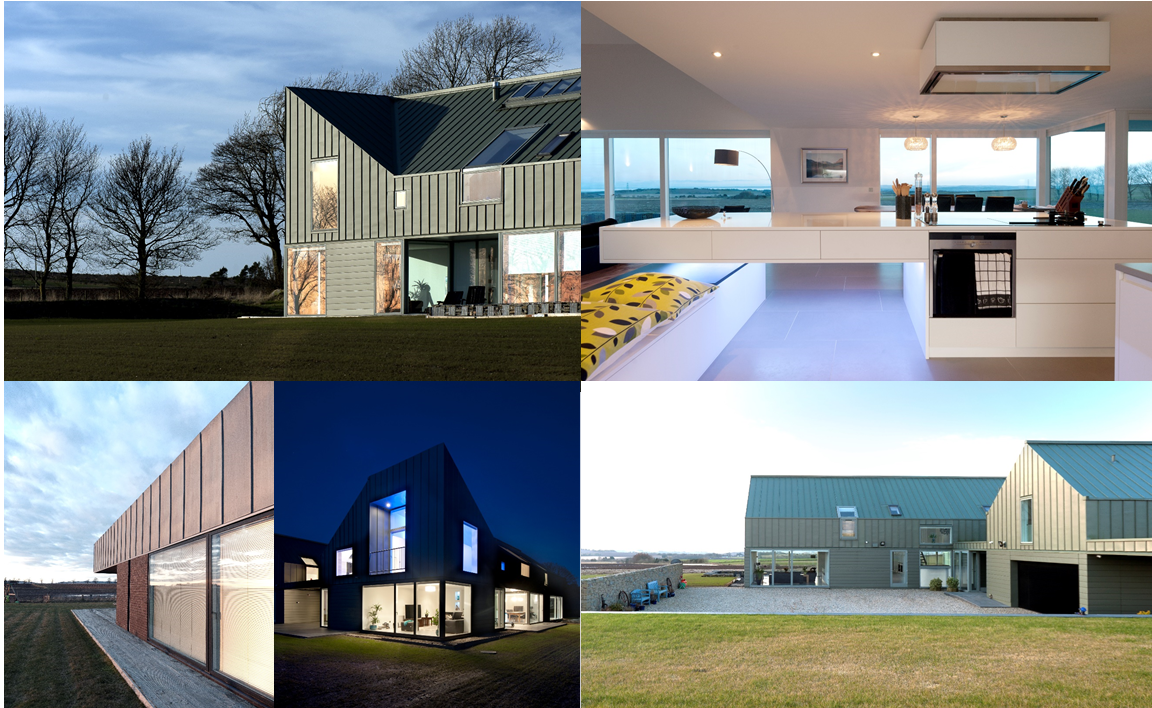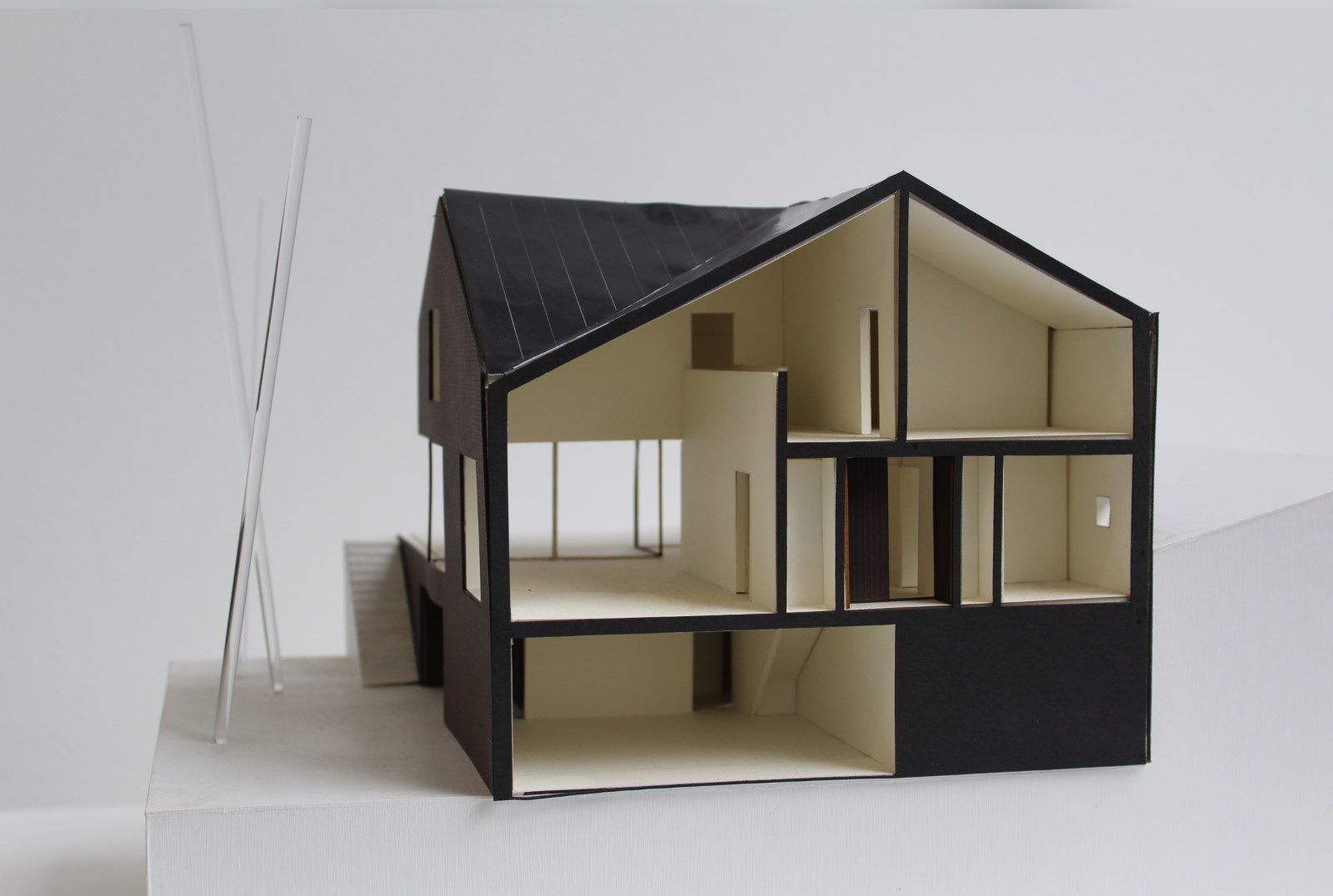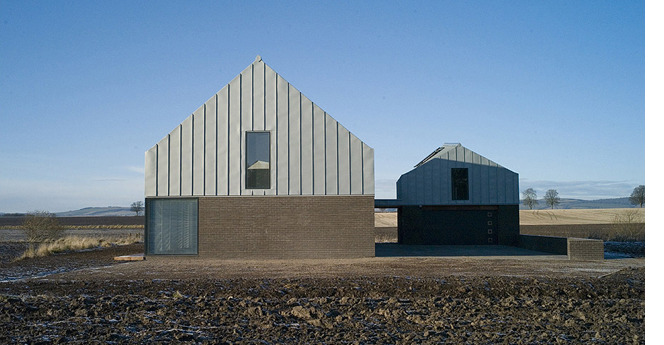
Each month we interview individuals or organisations based in Dundee that focus on design to complement Scotland’s Year of Innovation, Architecture and Design. This month we caught up with Graeme Hutton and Mark O’Connor from Leadingham Jameson Rogers + Hynd (LJRH) architects. Whilst Mark is based at the practice and teaches at DJCAD one day a week, Graeme is Professor of Architecture and Associate Dean of Learning and Teaching at Dundee University and works with LJRH on certain projects. A project they’ve both worked on, the Zinc House, recently scooped up a RIAS Award and gold award in the Residential category of The Scottish Design Awards 2016.
The zinc inspired house in Monikie has also been shortlisted for Grand Designs RIBA House of The Year 2016, which recognises the 20 best new houses designed by architects in the UK, and is due to air on Channel 4 in November. With so much talent from a small firm, our interview explored the relationship LJRH has with Dundee University, as well as how being based in Dundee has impacted their practice.
Can you describe a typical working day?
Graeme: It varies from both our perspectives which is interesting, but that’s what makes the collaboration between LRJH and Dundee University strong. I spend about 200 hours a year on scholarship, which is my practice effectively, so when Mark and I get together it’s very intensive and design focused. Most of my other time is working at the University as a professor of Architecture and I think it’s very beneficial for architects who are in academia to dedicate time to continually practising their art.
Mark: My day kind of an inverse of Graeme’s – I’m a practising architect but I do come into the art college to teach one day a week during semester time. The rest of my time is based at the practice working on live projects, and only a part of that is design focused, the rest is communications and planning. There’s a real benefit in teaching, because not only are you contributing something, but you’re also constantly having to refresh your own ideas and knowledge.
Graeme: I think it’s critical for an academic to stay in touch with their industry to keep a foothold in the world. I think it was Zaha Hadid who was asked, “What is an architect’s main role?” before she replied, “It’s about ideas and practise, practise, practise, practise!”.
Mark: There is a danger when you’re working solely in practice of your ideas starting to wither a little, and there can be a tendency for architects to play it safe and stick to what they know. But in the dialogue between Graeme and I myself, we challenge one another and that helps to keep you fresh. We’ll bounce ideas off each other and respond with honesty which is very important.
Graeme: it’s all fun – fun, architecture and money! You need 2 of the 3 to begin to make a good project.
What made you both interested in becoming architects?
Mark: My earliest memory of being interested in architecture was playing with Lego. I remember building a little house and my father saying, “That young man is going to be an architect someday”. I thought, “Oh, that’s interesting,” and it was tucked away at the back of my mind. I then went on to study at DJCAD and have been in Dundee ever since.
Graeme: For me, it wasn’t so natural. I wanted to do photography originally, which is still a burning passion of mine, but I wasn’t good enough to be accepted to study it. I ended up following a girlfriend up to Aberdeen and looked at studying there. I studied architecture at Robert Gordon University and became quite good at it but it wasn’t a natural instinct. I had studied a bit of interior design in Dundee at the College of Commerce beforehand so I guess architecture is a stepping stone from that.
Why have you both chosen to be based in Dundee?
Mark: The time that I graduated was during an economic downturn in the industry and jobs were pretty hard to come by. I happened to have at that point in time, a certain set of skills and abilities in computing that were fairly new and emerging so I was able to find a place in a local practice. Not everybody was lucky enough to get a job after graduating so it was a case of grabbing the opportunity – after 9 years I moved around a bit and then found myself at LJRH.
Graeme: It’s a bit of a sad story how Mark began with us actually. I worked with the practice (before Mark came) with David Jameson and we did The Shed together which was an award winning house in Meigle. We worked closely together but unfortunately he was unwell and died at the age of 37. Although he was working in the office until a week before his death, when we knew he was dying, I thought Mark would be a great fit for the office as he had a similar skill set to David. Part of our work is the legacy of David, and he remains the J in LJRH.
Mark: Many of the ‘seeds’ for projects we’ve made were in the discussions with David, and the framework of ideas that drives our practice forward grew from the discourse with him.
Do you find clients yourself or bid for contracts that you know are coming up?
Graeme: We’re very lucky that because of our growing reputation people approach us. We’re meeting with a couple this week who are wanting us to design their home based on seeing the Zinc House, and fortunately planners are saying to people who are looking to build in sensitive locations to look at our portfolio – amongst others, because it’s difficult to find a grammar of buildings in rural landscapes that don’t suburbanise them. You’ve got to find a way of building which is sensitive to the landscape and interestingly, both our award winning houses are passed by people every day who either don’t notice them (which is great, actually!) or think they’re conversions. They just assimilate themselves into the landscape that it’s not until you get up close you realise it’s a modern building.
Mark: There’s something very interesting in the idea of a building that reads differently depending on whether it’s viewed close up or from further away. Graeme had mentioned that the planning department have at times pointed people in our direction when they are seeking to build houses in the countryside, and this is how the Zinc House came about. A couple had put in an application for a large, suburban-style house which had passed through the planning process but was in the end turned down. It was suggested that the applicants look at our design for the Shed and they were very interested, ultimately becoming our clients.
Do you work a lot with the planning department?
Graeme: As architects, we do work with the planning department when carrying out work. If one of our houses or buildings have won an award, we always write to say thank you for supporting these projects. The Scottish Government have also put The Shed on their website as an exemplar of how to build in the Scottish countryside, and Angus Council recently approached us to supply them with images of the Zinc House to do the same.
Mark: It’s important to acknowledge when planning officers (who can get a lot of criticism) stand up and support something innovative, and that we say thank you when they back an unusual project.
Do you find it difficult to be innovative or do you have a certain style?
Graeme: I’m very interested in type. We’re not looking for the novel, new things but we’re looking for a type that changes and is reflected depending on place. Each place has it’s own set of characteristics, and it’s important to lead the landscape. These are often drivers of any innovation.
Mark: Yes, it’s important to read a place. We don’t start by thinking, “We’re going to design an innovative building”. I hope instead that we design buildings which are rooted in their landscape. The joy of building grows out of that very close connection between what you’ve constructed and what’s around it.
How has being based in Dundee impacted LJRH?
Mark: Like many firms, LJRH do a wide range of work. There are many straight forward, simple projects that are effectively the main income of the practice. These happen in and around the Dundee area but in terms of projects like The Zinc House, there aren’t so many here as in areas such as the outskirts of London, Edinburgh etc. but the fact that we make projects that are unique to this area is quite interesting.
Graeme: It’s also nice to not be in the ‘stockbroker belt’, we’re not in a rich hinterland of urbanists who want to build some great suburban villa. Our clients are very in tune with the area because they’ve most often grown up here so they’re more integrated with the place they live in and are quite receptive of not being showy. Both clients we’ve had to do those projects have been superb – they’ve had enough money to build a really nice house, but it’s quiet – and I respect that.
Mark: Interestingly, both are very rooted in this area. For example the client for The Shed, his family have been living and working in Meigle for several generations and they’re really locked into the area.
Graeme: It’s really enjoyable to work with clients like them who are not just using the house as a sort of trophy. It’s also great that they’ve chosen a local firm – it shows that they are in tune with their local area. We have global aspirations because the University has global aspirations so I think that’s a good interface with a practice where the expectation of me is to produce work at a level which is internationally recognised and I believe both these houses are. We and the practice benefit from that – it’s the discourse of LJRH being professional and whilst the university is local, it has global aspirations. We’ve been featured in publications such as The New York Times, which has helped to promote our practice globally, but we’re rooted in Dundee. Seamus Heaney, a Nobel Prize winning poet who was an honorary graduate described Dundee University as having its head in the clouds and its feet firmly on the ground, and I think that’s absolutely true.
What’s your thoughts of the Festival of Architecture finale happening in Dundee?
Graeme: I think it’s excellent, anything to raise the profile of architecture and design is a really good thing. I think a lot of architects, and people from other design disciplines, sometimes suffer from the stigma that they’re elitist, expensive or unnecessary so I think anything that grounds architecture in its locality and celebrates the professionalism of being an architect, and working with architects is great.
Mark: A lot of the events throughout the Festival of Architecture have been very accessible, a great example is The People’s Tower: Dundee Royal Arch. The cardboard structure particularly appealed to the imagination of children and it goes back to the Lego experience – architecture can seem like a difficult thing for a child to become interested in, but events like the cardboard arch can encourage younger people to think about the possibilities of building.
What’s your take on Dundee’s redevelopment?
Graeme: We’ve been working closely with the city on the waterfront regeneration for a number of years and looking at ideas for that. I think it’s fantastic – Dundee has the scale where it can make a fantastic laboratory of skills. Mike Galloway is doing a fantastic job and is nationally recognised as driving change for the city. The important thing for us, and one of the things we did for Festival of Architecture as a school, is to make sure that that concentration on the centre benefits outlying communities. Architecture plays a key role in the city’s redevelopment which can help to transform the lives of many residents. We raised this in the University, and had students pitching for communities in a ‘Dragon’s Den’ format, to get a project for their community to show the importance that good design makes a difference – whether that’s architecture or not.
Lastly, what advice would you give to architect graduates or those looking to set up their own firm?
Graeme: That’s an interesting question, we had Charles Jencks as our honorary graduate this year and he delivered a great speech. He talked about the nature of self-employment and how an increasing number of younger people coming into business now have opportunities there because there is more of an infrastructure about making your own business and doing your own thing. He sees that as a great opportunity for people to start doing things themselves and I think as educationalists we need to prepare more people for that. At the University I’m looking at final year modules which engage more with business and entrepreneurial skills so that students come out feeling as though they can develop a business idea. Bigger, more established practices could also look after them almost as though they’re a little franchise and so empowering graduates in this new culture of self-employment is important.
Mark: My advice to graduates is simply this: find the thing that you’re interested in and pursue it as far as you can.
Graeme: That ties in with what Jencks was saying about fun. Don’t go into somewhere dull and think you’ll only do it for a year because before you know it, 30 years have passed. Find what interests you when you graduate and pursue it. It might take a year or two, but once you find it, you’ll enjoy your life more.



